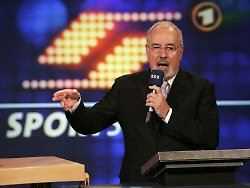Friday 4th June 2021
Congratulations on the 60 year old!
The bizarre beginnings of the sports show
It was a premiere with almost complete exclusion of the television public: When the ARD sports show first went on air on June 4, 1961, the TV monopoly at the time hid the new product on ARD 2. A niche channel. Incredible actually.
There is no time for a celebration. When the most important and most successful sports broadcast in the republic turns 60 today, the “Sportschau” team is in the final sprint of preparation for the European Football Championship. And on Saturday there is also no edition of the ARD classic. Because the Bundesliga is paused – the heart of the “Sportschau”.
Without the Bundesliga, the show would not have become such a TV legend. The league did not even exist when the “Sportschau” was broadcast for the first time on June 4, 1961 – a Sunday. Short films in black and white about handball, rowing, cycling and sand track riding, broadcast on Sunday evening at 9.45 p.m. – that was all for now. Broadcast on ARD 2. A niche channel that only ten percent of those interested in sports could receive at the time and whose frequencies fell to ZDF almost two years later.
Football appeared for the first time after eight broadcasts, with the game Tasmania Berlin against Altona 93. It was not until 1965 that the German Football Association allowed moving images from the Bundesliga, when the league was already two years old. “The Sportschau was only allowed to show three games at the time, because the DFB took the erroneous view that if more football was shown, fewer people would go to the stadium. The opposite turned out to be correct,” says the long-time WDR sports director and “Sportschau” presenter Heribert Fassbender.
“The heroes of that time”
The way of working in the first years of the sports show seems adventurous today in the digital age. “At half-time, a motorcyclist picked up the first film rolls to take them to the Kopierwerk in Cologne. The second sometimes risked head and neck after the game. Those were the heroes of the time,” says Fassbender.
It was the time of moderators like Ernst Huberty and Addi Furler, and later of Faßbender (“‘n Abend everyone”). They became television stars like Peter Frankenfeld and Hans Rosenthal. Up to 15 million people watched the “Sportschau” – “without the viewers in the GDR that have not yet been recorded by the audience research,” says Fassbender. “It was sports show time on Saturdays between 6 p.m. and 7 p.m. at that time. You weren’t even allowed to call your aunt,” he says with a smile.
Every football fan over the decades has his own connection with the “Sportschau”. “I can really remember my childhood, even when I was younger than ten, when I sat at home with my father and watched the” sports show “,” said Jessy Wellmer (41) shortly before her first moderation of the Saturday edition four years ago . She described the program as “the country’s cultural heritage”.
The importance of the Bundesliga for the “Sportschau” was particularly evident in its worst crisis. “The private broadcasters drove up the rights costs enormously and secured the rights to the top German soccer class,” Faßbender remembers. In the time of RTL from 1988 the “Sportschau” could still show pictures from the Bundesliga. The private broadcaster had the first area code. “But for some time we still had higher ratings than the show” Anpfiff “, which lasted up to three hours and for which the final whistle was again after four years for cost reasons,” says Fassbender.
“Still a family event”
When Sat.1 then summarized the Bundesliga on “ran”, the “Sportschau” had to get by temporarily without moving Bundesliga images. The audience ratings dropped drastically because viewers were only offered photos of Bundesliga results read aloud. In 2003 the “Sportschau” celebrated a comeback thanks to the return of the Bundesliga reports, and the TV myth came to life again.
“It’s still a family event,” says Steffen Simon. The current director of the show, previously under contract in private television, asked the rhetorical question: “Can you get children to linear television? Yes, with the” Sportschau “. We survived the i-phone, which is perhaps the greatest achievement. “
On average, 4.789 million people watched in the past season. Only a few live broadcasts attract more sports enthusiasts to the screen. Thanks to the TV rights acquired in the previous year, the “Sportschau” can lure an audience of millions in front of the screen on Saturday afternoon for at least four more years.
And thanks to further rights, there will be further offshoots from the summer – in addition to the Sunday edition in the first. On Fridays from 10:30 p.m. on the ARD special-interest channel One, summaries of the 2nd Bundesliga will be available under the name of the sports classic, and highlight clips on the Internet at “sportschau.de” and in the app on Mondays from midnight.
.
